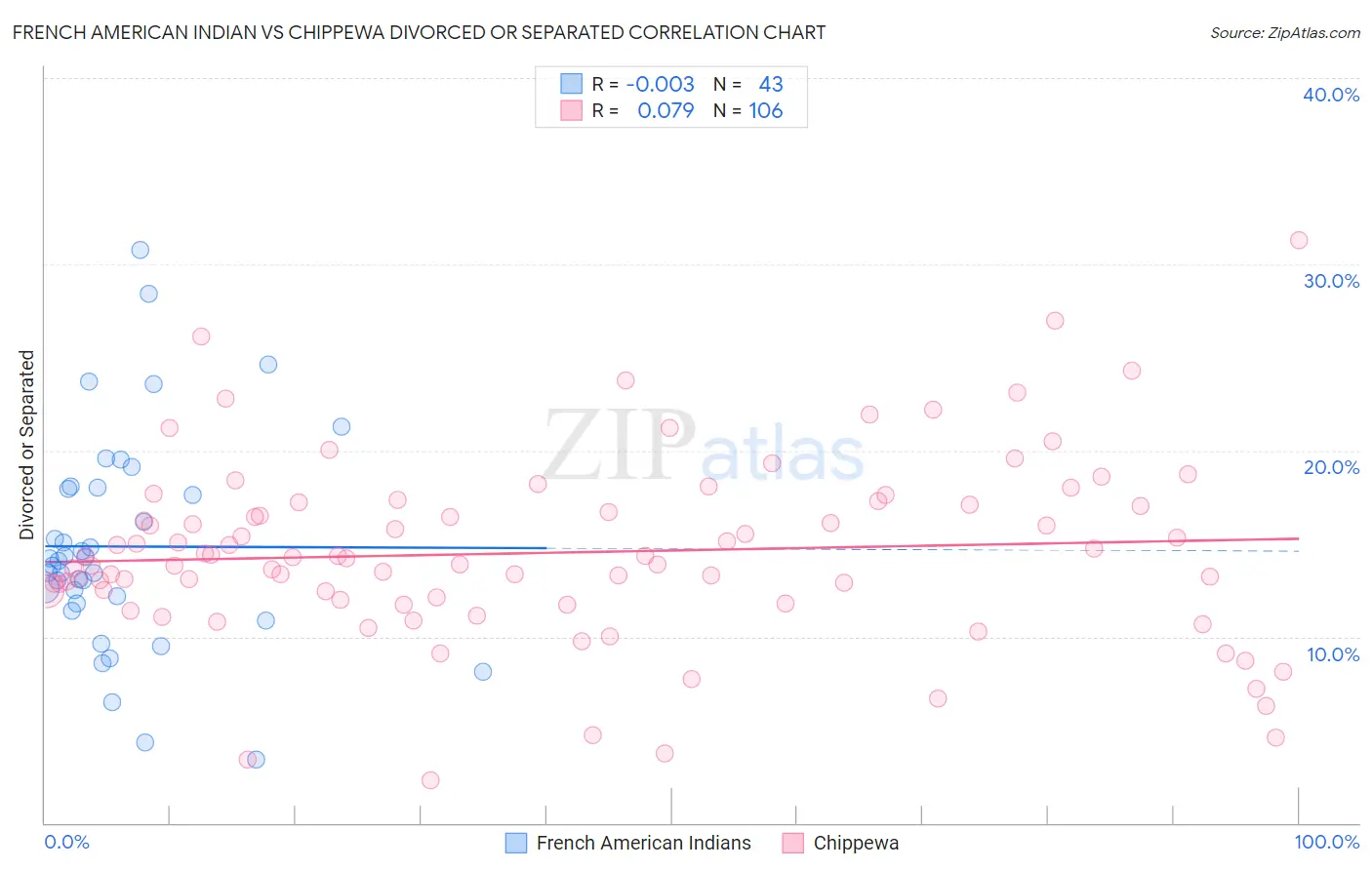French American Indian vs Chippewa Divorced or Separated
COMPARE
French American Indian
Chippewa
Divorced or Separated
Divorced or Separated Comparison
French American Indians
Chippewa
13.2%
DIVORCED OR SEPARATED
0.0/ 100
METRIC RATING
307th/ 347
METRIC RANK
13.2%
DIVORCED OR SEPARATED
0.0/ 100
METRIC RATING
305th/ 347
METRIC RANK
French American Indian vs Chippewa Divorced or Separated Correlation Chart
The statistical analysis conducted on geographies consisting of 131,970,450 people shows no correlation between the proportion of French American Indians and percentage of population currently divorced or separated in the United States with a correlation coefficient (R) of -0.003 and weighted average of 13.2%. Similarly, the statistical analysis conducted on geographies consisting of 215,036,643 people shows a slight positive correlation between the proportion of Chippewa and percentage of population currently divorced or separated in the United States with a correlation coefficient (R) of 0.079 and weighted average of 13.2%, a difference of 0.42%.

Divorced or Separated Correlation Summary
| Measurement | French American Indian | Chippewa |
| Minimum | 3.4% | 2.3% |
| Maximum | 30.8% | 31.3% |
| Range | 27.4% | 29.0% |
| Mean | 14.8% | 14.5% |
| Median | 14.1% | 14.2% |
| Interquartile 25% (IQ1) | 11.8% | 12.0% |
| Interquartile 75% (IQ3) | 18.0% | 17.1% |
| Interquartile Range (IQR) | 6.2% | 5.1% |
| Standard Deviation (Sample) | 5.8% | 4.9% |
| Standard Deviation (Population) | 5.7% | 4.9% |
Demographics Similar to French American Indians and Chippewa by Divorced or Separated
In terms of divorced or separated, the demographic groups most similar to French American Indians are Ottawa (13.2%, a difference of 0.090%), American (13.2%, a difference of 0.10%), African (13.2%, a difference of 0.12%), Sioux (13.2%, a difference of 0.14%), and Tlingit-Haida (13.2%, a difference of 0.25%). Similarly, the demographic groups most similar to Chippewa are Hopi (13.2%, a difference of 0.050%), Tlingit-Haida (13.2%, a difference of 0.16%), Cape Verdean (13.1%, a difference of 0.18%), Immigrants from Venezuela (13.1%, a difference of 0.20%), and Alaskan Athabascan (13.1%, a difference of 0.30%).
| Demographics | Rating | Rank | Divorced or Separated |
| Nicaraguans | 0.0 /100 | #296 | Tragic 13.0% |
| Natives/Alaskans | 0.0 /100 | #297 | Tragic 13.0% |
| Venezuelans | 0.0 /100 | #298 | Tragic 13.0% |
| Immigrants | Jamaica | 0.0 /100 | #299 | Tragic 13.0% |
| Immigrants | Cabo Verde | 0.0 /100 | #300 | Tragic 13.1% |
| Alaskan Athabascans | 0.0 /100 | #301 | Tragic 13.1% |
| Immigrants | Venezuela | 0.0 /100 | #302 | Tragic 13.1% |
| Cape Verdeans | 0.0 /100 | #303 | Tragic 13.1% |
| Hopi | 0.0 /100 | #304 | Tragic 13.2% |
| Chippewa | 0.0 /100 | #305 | Tragic 13.2% |
| Tlingit-Haida | 0.0 /100 | #306 | Tragic 13.2% |
| French American Indians | 0.0 /100 | #307 | Tragic 13.2% |
| Ottawa | 0.0 /100 | #308 | Tragic 13.2% |
| Americans | 0.0 /100 | #309 | Tragic 13.2% |
| Africans | 0.0 /100 | #310 | Tragic 13.2% |
| Sioux | 0.0 /100 | #311 | Tragic 13.2% |
| Blackfeet | 0.0 /100 | #312 | Tragic 13.3% |
| Immigrants | Nicaragua | 0.0 /100 | #313 | Tragic 13.3% |
| Yaqui | 0.0 /100 | #314 | Tragic 13.3% |
| Spanish Americans | 0.0 /100 | #315 | Tragic 13.3% |
| Tsimshian | 0.0 /100 | #316 | Tragic 13.3% |